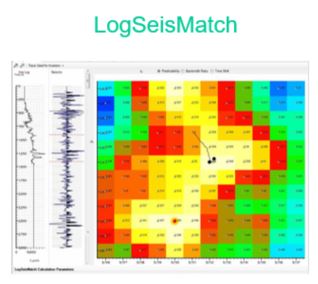For improved results in the Simulated Annealing inversion, both for post-stack and pre-stack equivalents, the ability to extract a composite seismic trace along the borehole track has been added. This results in better estimated wavelets, and thus a better inversion result where wells are highly deviated. The option is found in the LogSeisMatch module under the “Trace Used for Inversion” menu.
The pre-stack analysis module has a new Inversion Validation tool, allowing fast & convenient comparison of logs with the inversion results. In addition to allowing comparison of elastic property volumes (such as Vp/Vs, Poisson’s ration & Young’s modulus) with the well log equivalents, scaling of volumes to petrophysical properties (porosity, Vsh, Sw, TOC etc.) can be performed. Cross-plotting between the well log and property volumes allows assessment of the match both visually and by cross-correlation.
The Simulated Annealing Inversions can now optionally output low-frequency acoustic impedance, shear impedance and density volumes as applicable, in addition to the inversion and synthetic results, if required. These volumes can be used as models in the next test run, saving time to re-parameterize jobs. They can also be used for cross-validation of inversion results in the new Inversion Validation tab.
Constrained Cascaded Pre-stack Inversion (PSI)
This leverages the Simulated Annealing Inversion technology for a multi-parameter approach to uniquely identifying rock & reservoir properties. The techniques are suitable for both conventional and unconventional targets. This will generate acoustic impedance, shear impedance & density volumes which can be correlated with logs and transformed into petrophysical properties for mapping and analysis. Typical properties are Poisson’s Ratio, Lambda-Rho, Mu-Rho, Young’s Modulus and Brittleness/Ductility. Inputs required are typically angle stacks, compressional and shear velocity logs from a well (or wells) tied with a high quality time-depth chart, and a velocity or impedance volume to constrain the inversion.
Log Analyses
The Log Analysis tab shows a display of various elastic logs commonly used in the industry, derived from the three fundamental logs – Vp, Vs and Density (Rho). Other, petrophysical logs may also be sensitive or important to evaluating the data such as gamma ray, water saturation, total organic carbon (TOC) so they can also be displayed alongside (taken straight from Kingdom). From the series of displays you can pick up on what elastic properties can be used and the sensitivity of the logs to the prospect with some elastic logs being sensitive to fluid while others are sensitive to lithology or rock matrix. Any number of logs can be displayed dependent on how many you have selected. The logs plotted are useful for typical sand classification.
The plot will display the robust regression linear fit if selected and the Mudrock line if the plot is Vp vs Vs. Gardners Rule will be shown if the plot is Vp vs Rho in the Log Scale. In rock physics and petrophysics, the Mudrock line, (also called Castagna’s equation or Castagna’s relation), is an empirical linear relation between seismic P-wave velocity and S-wave velocity in brine-saturated siliciclastic rocks (i.e. sandstones and shales). Gardners Rule relates seismic P-wave velocity to the bulk density of the lithology in which the wave travels. It can provide information about the lithology from interval velocities obtained from seismic data. The constants are usually calibrated from sonic and density well log information but in the absence of these, Gardner’s constants are a good approximation
Polygons can be drawn over areas of the cross plot where shales, for example are thought to be. The data point samples within the polygon will be highlighted on the well log in the Log Analysis tab thus showing you can isolate lithologies by elastic parameters.


